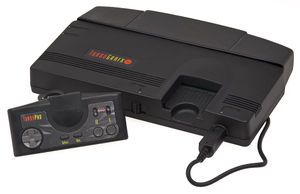Difference between revisions of "Configuration:TurboGrafx16"
| Line 22: | Line 22: | ||
* [[Emulator:Mednafen|Mednafen (PC Engine/TurboGrafx-16)]] | * [[Emulator:Mednafen|Mednafen (PC Engine/TurboGrafx-16)]] | ||
* [[Emulator:Mednafen-PC Engine CD|Mednafen (PC Engine CD/TurboGrafx-CD)]] | * [[Emulator:Mednafen-PC Engine CD|Mednafen (PC Engine CD/TurboGrafx-CD)]] | ||
| + | |||
| + | == External Link == | ||
| + | [https://en.wikipedia.org/wiki/TurboGrafx-16 Wikipedia] | ||
[[Category:Platform]] | [[Category:Platform]] | ||
Revision as of 08:43, 23 May 2016
| TurboGrafx16 | ||
|---|---|---|

| ||

| ||
| Manufacturer | NEC Hudson Soft | |
| Type | Home video game console | |
| CPU | Hudson Soft HuC6280 | |
| GPU | TBA | |
| Sound CPU | TBA | |
| Sound Chip | TBA | |
| Memory | TBA | |
| Controllers | Control Pad | |
| Year | 1987 | |
Platform Information
from wikipedia
The TurboGrafx-16 Entertainment SuperSystem, known in Japan and in France as the PC Engine (PCエンジン Pī Shī Enjin?), is a home video game console joint-developed by Hudson Soft and NEC, released in Japan on October 30, 1987, in the United States on August 29, 1989, and in France on November 22, 1989. It was the first console released in the 16-bit era, albeit still utilizing an 8-bit CPU. Originally intended to compete with the Nintendo Entertainment System (NES), it ended up competing with the Sega Genesis, and later on the Super NES.
The TurboGrafx-16 has an 8-bit CPU, a 16-bit video color encoder, and a 16-bit video display controller. The GPUs are capable of displaying 482 colors simultaneously, out of 512. With dimensions of 14 cm×14 cm×3.8 cm (5.5 in×5.5 in×1.5 in), the NEC PC Engine once held the record for the world's smallest game console.
In France, the system was released shortly after its American debut under its original Japanese name, PC Engine. In the United Kingdom, Telegames released a slightly altered version of the American model simply as the TurboGrafx in 1990 in extremely limited quantities. This model was also released in Spain through selected retailers. Although there was no full-scale PAL region release of the system, imported PC Engine consoles were largely available in France and Benelux through major retailers thanks to the unlicensed importer Sodipeng (Société de Distribution de la PC Engine, a subsidiary of Guillemot International).
The TurboGrafx-16 failed to break into the North American market and sold poorly. However, in Japan the PC Engine was very successful, briefly outselling Super Famicom, and eventually being in a steady second place, ahead of the Mega Drive. Two major revisions, the PC Engine SuperGrafx and the TurboDuo, were released in 1989 and 1991, respectively. The entire series was succeeded by the PC-FX in 1994, which was only released in Japan.
Media Devices
- ROM Images
BIOS
A BIOS image is required to run PC Engine CD emulators. A BIOS image should be dumped from your own hardware.
Available Emulators
Below is a list of available emulators for this platform.